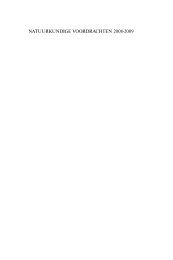Jaarboek no. 89. 2010/2011 - Koninklijke Maatschappij voor ...
Jaarboek no. 89. 2010/2011 - Koninklijke Maatschappij voor ...
Jaarboek no. 89. 2010/2011 - Koninklijke Maatschappij voor ...
You also want an ePaper? Increase the reach of your titles
YUMPU automatically turns print PDFs into web optimized ePapers that Google loves.
Applications<br />
Beside their purely fundamental interest, switchable<br />
mirrors offer also attractive possibilities as smart<br />
coatings in electrochromic devices, as hydrogen<br />
indicators for catalytic and diffusion investigations,<br />
as the active layer in fiber optic hydrogen sensors<br />
and as hydrogen absorption detectors in a combinatorial<br />
search for new lightweight hydrogen storage<br />
and membrane materials.<br />
a. Hydroge<strong>no</strong>graphy<br />
Gremaud et al. 8 recently developed Hydroge<strong>no</strong>graphy,<br />
a combinatorial technique that allows to<br />
simultaneously measure the hydrogen absorption<br />
isotherms of thousands of thin film metal-hydrides,<br />
Natuurkundige <strong>voor</strong>drachten I Nieuwe reeks 89<br />
Schakelbare spiegels: een samenspel van licht en waterstof<br />
Figure 2<br />
Stills of a movie showing the switching from metallic reflecting to transparent and back to the metallic state in a<br />
Magnesium-Gadolinium thin layer. After introduction of hydrogen the layer switches within a few seconds to the<br />
transparent state. Introduction of oxygen (or simply ambient air) brings the mirror back to its original reflective state<br />
within a few minutes.<br />
Figure 3<br />
Optical appearance of a thin layer of Magnesium-Titanium. Without hydrogen, the layer is reflective while it is strongly<br />
absorbing in presence of hydrogen. The residual reflectance is due to the glass substrate on which the Mg-Ti film is<br />
sputtered.<br />
by following the optical changes occurring upon<br />
hydrogenation. In a Hydroge<strong>no</strong>graphy experiment<br />
the amount of light transmitted through a thin film<br />
is recorded as a function of the hydrogen pressure in<br />
equilibrium with the sample. According to the Beer-<br />
Lambert law, the logarithm of the optical transmission<br />
is directly proportional to the hydrogen<br />
concentration in the material. The Pressure-Optical<br />
Transmission-Isotherms obtained with hydroge<strong>no</strong>graphy,<br />
in which the hydrogen pressure is plotted<br />
as a function of the logarithm of the optical transmission,<br />
are therefore equivalent to the standard<br />
Pressure-Composition-Isotherms measured in conventional<br />
metal-hydride research. The advantage<br />
of Hydroge<strong>no</strong>graphy is that it allows to measure the<br />
31




